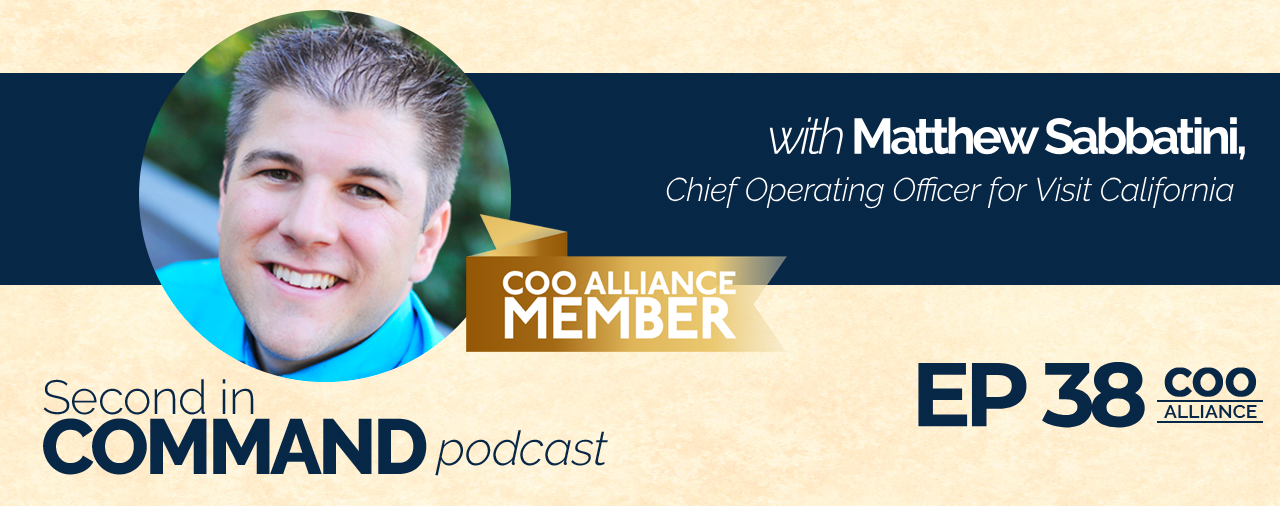Our guest is COO Alliance Member Matthew Sabbatini, COO at Visit California.
In growing your business, efficiency and effectiveness within the organization are something to seriously consider. Effectiveness is vital for growth whilst efficiency is vital for profitably. Matthew Sabbatini, the COO at Visit California, imparts the success journey of their company where they focus on tourism marketing, owing it to the core values instilled in their organization. Over the last fourteen years, it has grown from eighteen employees and $7.5 million budget to 75 employees and over $130 million budget. On top of that, he dives into leadership, organizational culture and marketing strategies.
Resources:
Connect with Cameron: Website | LinkedIn
Get Cameron’s latest book: The Second in Command – Unleash the Power of Your COO
Subscribe to our YouTube channel – Second in Command Podcast on YouTube
Get Cameron’s online course – Invest In Your Leaders
—
Visit California COO, Matthew Sabbatini
Matthew Sabbatini is the Chief Operating Officer for Visit California, a nonprofit organization created to increase tourism and market California as a premier travel destination. He oversees several departments, managing the organization’s $130 million budget as well as financial policies and technology systems. With more than fourteen years of experience of Visit California, Matt has successfully led the organization to continue its track record of 21 years of unqualified audits. Matt has more than twenty years of operations and executive experience and is the recipient of the 2011 Business Journal’s CFO of the Year Award. A California native and an Auburn resident, he and his family enjoy the state’s abundance and love to travel. He is also a former member of the COO Alliance. Matt, welcome to the Second In Command podcast.
Thank you for having me.
It’s funny when I think about marketing California as a tourist destination, I’m like, “Dang.” You’ve got one of the top three. What do you get in California, Italy and the Taj Mahal? What is it that they’re trying to do? Give us a little bit of an overview of the organization because clearly, I probably understated how important it is.
Ultimately in the most simplistic form, we are trying to inspire travelers to come to California with the intent of increasing the tourism economy within California. We have the largest tourism economy in the US. Obviously, our charge has changed over the years that Visit California has been around. We’ve always stuck to one core mission and that is do what the industry cannot do for itself. Collectively, with our funds, we are able to go out and market internationally, whereas an individual business, whether it be a hotel or a restaurant, doesn’t necessarily have the money to go out and do that and market themselves in those markets around the world. We’re able to do that. That has changed in many different forms over the years.
One of the things that we’ve taken charge of over the last couple of years, obviously as everybody knows, California has its share of natural disasters. One of the things that we have done aside from marketing California is making sure that we’re doing crisis communication for the tourism industry. We get the message out there that while there are certain parts of California that may be on fire and despite what the media is reporting that the entire state is on fire, California is a huge destination. Most people don’t realize the geographical size of California and that you can still come here and do everything that you probably want to do, even if there is a fire happening.
I hadn’t even thought of that whole crisis communications side of things. I was thinking about pure destination marketing. When I think about the fires in Malibu and the Camp Fire at the whole North of LA section that was on fire, it’s probably quite small compared to the massive state. Is that a big part of the role of the organization?
It’s becoming a bigger part of the organization. I would say when I started here, it wasn’t even something we thought about. The disasters that California had were not anything quite as disastrous or as huge as what they are. Visit California was born out of the earthquakes that happened back in ’89. That’s what history got together because media was reporting that California is going to fall into the ocean. We had to do something. Obviously, California is a destination where people are going to come no matter if you’re marketing or not. The volume and the market share that you lose when you’re not marketing and it’s so easy for other destinations, Florida, Hawaii on the market share.
Back to my first time to San Francisco, I don’t remember exactly when it was. I remembered the plane was touching down and there was definitely a palpable sense of nervousness that I had about an earthquake coming in San Francisco. The reality is I’ve lived in Vancouver for longer than that. Vancouver is in an earthquake zone and I never worried about it there. There were no earthquakes. I walked around for three days expecting one every 30 seconds. No earthquake is coming.
The reality is they don’t happen that often whereas you get hurricane season every single year.
Tell me about the growth of the organization. You have had some pretty crazy growth over the years you’ve been there. In that period of time, what was your employee growth? What’s your budget been? $130 million budget right now is a huge amount of growth. In the years, you’ve been there, what’s your budget grown by and what’s your number of employees just so we can understand the scope of the organization you’re running?
When I started, our budget was about $7.5 million. We had about eighteen to twenty employees. Now, we are at about $130 million and we have 75 full-time employees. What I think has grown more than the number of employees is what we call our Visit California extended family. That means the thirteen offices around the world. What we do is we contract with companies that are destination marketers. They specialize, they work with the trade, they work with the airlines and etc. to market a specific destination. We’re in thirteen markets. We have more than that. We have six offices alone in China. If you start adding in that global extended family, we’re about 400 people that are working on the Visit California marketing on any given day.
I love the campaigns. You probably see them because you travel as much as I do, where you’re walking down the gangway from the gate to the door of the plane and there’s all the HSBC. They have such a strong targeted campaign for their business traveler. You’re $130 million, how much of that would be marketing do you think? Where are you guys shifting your marketing? Where’s your focus?
One of the things that personally has made us very successful is that we keep our operational costs very low. We run at about 12% operational cost. Unknown to most nonprofits that run at 30%, 40% or frankly at other destination marketing organizations like us. That’s because we want to focus on marketing. Every dollar we take out of marketing or put it into market operations is being taken out of marketing. For every dollar we spend, the tourism industry gets about $300 back. You can see why we’re trying to put as much in the marketing as possible. We spend about 88% of our budget on true marketing. That comes in many different forms, whether it be TV or digital or marketing to the trade, etc.
To answer your question there, where are we going? Things are moving digital. When I started, our budget was very low. We were only doing print in the US. Maybe working with a little bit of trade and maybe one or two markets. Obviously, we’re working with the trade in all of the markets that we’re in. We’re spending probably $15 million a year there. When we had our first burst in growth, we mostly were starting to go into TV in the US. That’s a primary market for us. Now, things are shifting whereas it’s probably 50/50 or 60/40 on the digital side and that’s changing. We’re making a lot of those shifts day in and day out. From a market perspective, the ones that are growing the fastest are going to be China and then second to that is India as the next up and coming market.
What are you seeing in India right now?

Tourism Marketing: Things are moving digital. They’re shifting where it’s 50/50 or 60/40 on the digital side.
It’s still what we call a tier three market for us as China was years ago, but we see the potential growth with their increase in middle class and how fast it’s growing, the sheer volume of individuals. The visas are still somewhat of a hindrance. If we get a visa waiver, that would make a huge difference in numbers. I would say in the next few years, I think we’ll start seeing India becoming the next China.
It’s going to be interesting to watch India evolve where they get their systems in business. Technology is going to help them with that where the cost of technology is getting so much lower. I’ve been to India four times over the last years. They do seem to be growing up almost as a country.
They love to come to California. We’re positioned to be the primary beneficiary of that because of the tech capital of the world. They’re being so heavy in technology.
They care about education. When I first met you, one of the things that I was impressed with was you were the nonprofit government guy in my mind only to find out that you’re not much government funding anymore. You treat this like it’s your business, which I was impressed with. I was touched that someone would run this like it’s theirs and treat it like it’s theirs. It was very different for me to see that. How is that you treat this and run this that way? Is that a mandate or is that you culturally? Does that culture permeate through the organization, do you think?
It’s a combination of things. It starts with our CEO from leadership. We like to say we’re the furthest thing from the government. When this started, it was a 50/50 partnership in terms of revenue from government and private industry. Obviously, that’s changed over the years. We get $200,000 a year from the state at this point. It’s all private dollars.
You get $200,000 from the state and then $129,800,000 from private?
Yes.
How do you do it? What’s the deal? Is it business development? Is it co-op?
Several years ago, a piece of legislation was formed by the industry that gives us the ability to collect. To answer your question of why do we run this organization like this is it starts from leadership? That’s how I am personally. We also have a six-year referendum. In the legislation that was formed several years ago, what says that every six years, the businesses that fund us get to vote on whether or not we stay around. That vote is coming up in November of ’19. Every dollar they pay, they get a vote. If we’re not doing a good job, then we’re not holding our staff accountable in passing and that’s why audits are so big to us. It shows the level of transparency to the industry of what we’re doing with their money. We have to look at it as we are stewards of their money and being efficient with that. At the end of the day, we have that what we call the six-year hammer.
You’re coming into that potentially post the economic downturn. We’re going to come into another economic downturn. It’s going to be hard. I’m an optimist. I still think it’s going to be a hard hit. You’re going to be coming into that vote potentially after it started or in the middle of it. What KPIs or metrics or what data do you show the industry then to get them to see it? How do you show them that you’re delivering? Also, do you measure anything ongoing? Do you have a Net Promoter Score or anything that you measure on going to feel the pulse of them that? I’m sure you don’t wait every six years to see, “How are we doing now?” You must measure ongoing some way.
We do continuous measuring. What we focus on is our ROI to the industry. We spend probably close to over $1 million a year on research. Most of our marketing is research-based. Our head of marketing doesn’t come in one day and say, “I have this cool idea. Let’s spend $1 million and try it out.” It’s all research-based so that drives the ROI. That’s basically our measurement. Because we’ve been doing this for so long, we have the historical knowledge. We can show those huge dips of when we stopped spending money the direct correlation to the market share of travelers. It’s very clear. The industry gets it. They see what we do. Frankly, when you’re in an economic downturn, it is all the more reason for what we’re doing because those businesses have even less to spend. Our funding model has changed over the years.
Years ago, when we made the second big jump from basically $50 million to $110 million, overnight we doubled. In the legislation, we were guaranteed $50 million. That was our budget. Now we’re more performance-based. As the industry does better, the more revenue we have. That’s why it’s continued to grow. We had a cap of $450 million. As goes with the upturns come the downturn. When the industry or the tourism industry is not doing as great, obviously our revenue may take a slight dip. We’re preparing. We’ve put rainy day funds in so that when that happens, we’ve done the research to show how much do we need to put away for the next economic downturn? Because to your point, it’s not if, it’s when.
You mentioned for every dollar owed, you have $300 in. Is that one of the key numbers that you show the industry then?
Yes.
Did I understand that right? If you spend $1 million, you can quantify $300 million in travel coming back in?

Tourism Marketing: As goes with the upturns come the downturns. When the industry is not doing as great, y our revenue may take a slight dip.
Correct. It’s not exactly $300. It’s like $330 something. I have that number off the top of my head right now.
I love that you under-promise and over-deliver. It’s not exactly $300 million. It’s more like $330 million. I’m like, “Okay.” Most entrepreneurs will be like, “It’s not $300 million. It’s more like $12 million.” Where do you collect them? Is this the tourism tax at hotels? Is that a part of your revenue or where do you guys get your revenue?
Tourism taxes go to local cities. That usually funds local city general funds. The businesses that fund us do have the ability to pass on our assessment. If you’re in California and you stay in a hotel, you may see California tourism assessment. Our fee is so much less. You look at transit occupancy tax, what you were referring to. You’re probably looking at anywhere from 8% to 15% of your total hotel bill. A $100 hotel nightly rate, you’re going to have $15 in TOT. Our assessment is $19.05. Some hotels choose to pass it on, some don’t. Some choose to roll it into all fees so they don’t have six different fees. Primarily the ones that do pass it on are hotels and rental cars, restaurants, retail, attractions. From the consumer mindset, it doesn’t necessarily lend to passing on those fees. They typically eat it out of their profits.
They are all contributing.
We have 18,000 business locations that contribute to our organization.
Do any of the businesses that you’re working with whether it be hotel chains or attractions, theme parks, etc., contribute their fees as contra? Do any of them give you gift certificates or credit lines or anything like that?
Not in that sense. We don’t operate that way. A lot of times what they will do is one of our marketing tactics is bringing in people from other countries here to experience California, whether it be media with the hopes of them coming back and writing about California and promoting it or whether it be trade so they understand California more so that they go back and sell more California packages. We will get trade rates on hotels. Sometimes we’ll get them comped for the media or free tickets to Disneyland for the trade or media. It’s always from a marketing perspective.
I was thinking when the Vancouver Olympics wrapped up in 2010, they contacted me a year later. I used to run a large barter company. We would help companies trade their products and services. The Olympics was sitting on $140 million of in-kind inventory. As an example, Polaris Snowmobiles gave them $5 million in snowmobiles for a bronze Olympic advertising sponsor. Shell Oil, the gas company gave them $10 million in gasoline credits to have a silver package. They were a silver sponsor of the Olympics. They didn’t pay $10 million in cash. They gave them $10 million in gas. During the course of the Olympics, the Olympics would sell off some of that $10 million credit to car companies or transportation companies or whatever. They were sitting on all this extra contra, this stuff that they couldn’t do anything. I was curious whether you were using any of that for your business at all. I like that you can pull stuff in on the marketing side though. We’ll see that. There was no real cost of goods sold for them to offer that up.
We know which partners and they all like to partner in doing that stuff. It’s interesting too when the economy is good, like right now, they’re comped at hotel rooms and all of that. When things take it to dip, if we want to continue with bringing people here, we usually have to start paying for them.
When you think that would be strange because the reality is they probably have less occupancy. They probably have these hotel rooms sitting there and nobody is renting anyway. The first group that I ever saw as a true destination marketing for a state or a country was I was living in Canada. In Toronto at the time and this was back in the early ’90s and it was Cuba. The country of Cuba had a huge advertising campaign for Canadians. Americans weren’t allowed to go to Cuba at the time but Canadians were. Everywhere I turned there were billboards about Cuba, these amazing beaches in Cuba. They’ll all be sponsored by airlines and stuff. I get that this destination marketing works. Do you outsource your marketing? Do you work with marketing groups? How do you pick the ones that you work with? How do you pick your partners? Do you run it all in-house?
We have an advertising agency that comes up with all of our marketing concepts. As we’ve grown, we have our main advertising agency. We started partnering. Over the last few years, it’s grown tremendously with Time Inc. which now is not Time Inc. They’re a huge partner for us. They developed a lot of our content. They produce our California visitor guide. That’s where we break the model where we don’t do a lot of this stuff in-house. We hire specialists to go out and do what they’re good at. Most of the staff internally are project managers. Obviously, we’re working with other destinations within California and we partner with them. We’ll do partner campaigns. For example, when the Middle East travel ban came out, we did a promotion that, “All Dreams Welcome.” It was primarily done for Mexico and Canada, those markets. We brought the governor. What we wanted to say was, “California stands apart.” We are in a way our own country and people have always thought about us that way. We want to push that message. We would then go out and partner with the destinations within California. We didn’t do that on our own.
We’ve also partnered all the time, mostly on the international space, with airlines. We’ll do a big promotion with British Airways when we’re doing a campaign in England or we’d done promotions with Air Canada. A lot of times with airlines, we’ll do partnerships. We also do partnerships with other brands. The one that comes to mind is in Australia. We did a huge partnership with Roxy so that pushed things there. We do partnerships one in France. They have their Miss France with a huge viewership and Miss France is coming to film that particular year in California. We did a huge partnership with them.
The ones in Canada that I remember always seem to have an airline partnership, so that makes a lot of sense. You are doing the same. Talk to me a little bit about running the organization and your leadership. You’ve been with them from the early stage and watched some rapid growth. Were there twenty employees when you got there?
Yeah.
Now, it’s like 75 to 400. You’ve clearly had to grow as a leader. How have you grown in your skillset? Give us a bit of your background as well. I know that you’ve got some finance background in you as well.

Tourism Marketing: When you take on that leadership, you have to be able to manage.
I tell the story of I started here at the bottom. Several years ago, I started as an assistant. I’ve always been business-minded. I take on new things. When I see an opportunity, I’m the type that gets in and gets it done. Within Visit California, I’ve run day-to-day facility operations. I’ve run literally in IT, setting up servers and whatever. I’ve ran the Finance Department. I went back and got my finance degree because I never had a degree before. I’m months away from my Master’s in Finance. It’s been an exciting career here. I’ve always grown in this company as a doer and so that has probably been the biggest switch for me over the last few years. Obviously, I’ve had to lead departments but nothing quite as big as it is now. You have to take on that leadership. You have to be able to manage. I’ve transitioned more from a day-to-day producer to a leader and manager of staff. At the end of the day, I know common sense isn’t so common anymore. Honestly, it’s not hard. It’s not a negative thing on anybody. You either have it or you don’t. That’s something that I feel like you can read a book and learn how to be a leader.
You said, “You either have that leadership ability or you don’t.” You can learn more but you either have those traits. The big one that you touched on and a lot of people miss this is it has to get done but not necessarily by you. In the early stages of growing any company, we need a lot of people. I call them jack of all trades, master of none. I was classic at that at 1-800-GOT-JUNK when I was the COO. I came in and right around when you did fourteen employees and I was doing it. All of a sudden, it was less about doing it. It was more about recruiting, leading and onboarding people. It was more about getting results through people, growing them. Walk us through some of your leadership then. How do you lead people? How do you grow people? How do you get results through people? Give us some thoughts around that.
For me personally, one of the first things I say in terms of leading people is lead by example. All of my team and frankly the entire office know that, if something needs to get done, I’m going to get in and help and do it because I’ve come in this organization essentially as an assistant. I’ve worked in probably five different roles to where I am. I know what it takes. I’m not the type that says, “Go do this.” I understand what it takes to get that done and I’m willing to help. I feel like I’m realistic about what things take as well. In terms of growing individuals, it’s a matter of making sure you’re available to your team. One of the things that I do is I set aside three hours every single day where I block my calendar. I call it “desk time.” It’s available for staff to come in and get the information that they need. That’s a huge part of my day to do that. It has been incredibly successful.
It’s like the professors in college have their open door where they’re sitting and doing work. If somebody wants to come in and ask them a question, they’re available for it. If an employee comes in and says, “Matt, what should I do about this?” How do you typically respond?
Honestly, I’m very analytical. I like to have data and details or facts behind things. I’ll ask a lot of questions, trying to get to what they’re trying to get after. Not necessarily tell them this is what I want you to do. What I try to do is help guide them but make it to where they come up with the answer themselves.
That was what I was hoping for without asking you the question. Years ago, I was being groomed by a guy who was being groomed as a COO at Starbucks. My mentor was a guy named, Greg Johnson. He’s reporting to the CEO at Starbucks at that time. Greg said, “When an employee comes into your office and says, “How do I deal with this?” The best thing for you to say is, “How do you think you should deal with it?” If they say, “I don’t know,” then say, “Go away and think about it and come back and tell me what you think.” If they say, “I think I should do this,” then say, “Do it.” It’s almost like you don’t engage.” I’m like, “That’s weird.” It’s like giving an open-door policy but it’s pointless to come in the door. He goes, “That’s the point. I don’t want them to continue to come to me for advice unless it’s truly needed and unless they’ve truly thought about it. My job is to grow their brains so they can solve problems but also to get them to keep thinking about it.”
It was a big lesson for me. You’re doing that, which is huge. I want to know where you’ve struggled as a leader over the years and something that you screwed up that you learned from. Like a big lesson from failure or from struggles. I had a year ago where I didn’t listen to our CFO. He was very quiet. I would steamroll over him. We almost lost the company because of it. I learned that if I’m going to have people on the team, my job is to listen to them. What’s one of yours in that area?
One of the things that I would say that comes to mind and it may not hit exactly what you’re after. I’ve had the opportunity to be mentored by our CEO who’s an amazing person. I was young when I came into this organization. With that comes some career immaturity. It was probably three, four years into being with Visit California and our finance director had left. Carolyn came to me and said, “Matt, I’m going to make you the acting Director of Finance. Get through the audit and get through the next board meeting and the job is yours.” I thought, “Okay.” I changed my email signature as acting director. About two, three months in and I don’t know what I was thinking but I thought, “People aren’t taking me seriously because I have this acting on there. I’m going to remove the acting.” I got called on. You learn from those things. At the time, you don’t realize the impact that something as simple as that makes, but it does make a huge difference. One of the things that I’ve always tried to learn from is that old saying, “You don’t know what you don’t know.” I’m trying to be cognizant of, “I don’t know everything,” and not trying to run over and take advice and learn from the experience of people that have been doing this longer than you.
This is to quote a pretty successful entrepreneur out of California. Everyone thinks he’s from Chicago. Ray Kroc, who built up McDonald’s said, “When you’re green, you’re growing. When you’re ripe, you’re rotting.” No matter where we are in our careers, we’re always learning. I want you to leave us with the one big lesson that if you were 21 years old, starting out in your career again, something that you’ve learned that you now know for sure is something that you follow, like a good tenet in leadership. What do you wish you’d known when you were 21 that you now know?
It goes back to what we were talking about is to treat this an organization or whatever you’re doing as if it’s your own. You spend money as if it’s your own pocketbook, whether it’s someone else’s or not. Operate with a 100% transparency. Be open to learning. You’ve made that quote from Ray Kroc. I’ll always say, “If you’re not growing, you’re dying.” I tell my staff that all the time. Always know that you have to continue to grow. You never know it all. I would say when I was 21, I didn’t think that way. You think you know everything. You’re king of the world, you really aren’t.
I’m glad you brought that one up. I’m also going to share one that I think you’ve learned and internalized. It was that in the early days when you were doing a lot of this international travel and the travel for business, you would tack on a couple of extra days to see the city and enjoy it. Now you’re realizing with kids that are thirteen and fourteen, it’s almost more important to be back with your family. It’s a true growth lesson for an entrepreneurial person or a leader of a company to recognize that this is what we do to make money. As much as we’re going to treat it like our own and be passionate about it, we also have that family that is our core. It’s great that you are that family person and a great dad as well.
As I’ve learned in Switch is that work-life balance is incredibly important. While I may not be tagging on trips for work purposes, we do vacation a lot regularly, but it’s more of a family vacation and I don’t have to think about work. We can check out and do our family thing versus tagging onto work.
If you couldn’t travel to California, where would you travel to? What state would you go to second place to California?
To be honest, we go to Hawaii every year. We do our family vacation every summer there. For me, it’s mostly being somewhere on a beach where I can shut my brain off and disconnect. It doesn’t matter whether it’s in Hawaii or California or Bali or wherever it may be. It’s about spending time with family and relaxing and being able to shut your brain off.

Tourism Marketing: Treat the organization or whatever you’re doing as if it’s your own. Spend money as if it’s your own pocketbook, whether it’s someone else’s or not.
You’re running the good ones. Congrats on everything you’ve done with Visit California. Thanks for sharing with us. I love to get you back out to another COO Alliance Event. Matthew Sabbatini, the Chief Operating Officer from Visit California. Thanks for sharing with us.
Thank you.
Important Links:
About Matthew Sabbatini

Matthew Sabbatini is the chief operating officer for Visit California. He oversees finance, human resources, information technology, assessment revenue and California Welcome Centers in managing the organization’s $130 million budget, as well as financial and accounting policies, technology systems, personnel and organizational controls.
With more than 14 years of experience at Visit California working to create an efficient global operating infrastructure to support Visit California’s mission, Matt has led the charge on cost-effective and innovative operational tools to scale Visit California’s international program of work, including the Dream Big Dividend operations activation plan. He previously served as Vice President of Operations; Senior Director of Finance, Human Resources and Information Technology; and Operations Manager and Commission Liaison, managing all aspects of the organization’s operational systems while acting as a direct liaison with Visit California’s 37 board members and numerous committees.
Matt has more than 21 years of operations and executive experience and is the recipient of the 2011 Business Journal’s CFO of the Year. Matt holds a bachelor’s degree in accounting from Colorado State.





